POOL EXERCISES FOR SHOULDERS.
All photos taken courtesy of Herongate Leisure centre Hungerford
Exercise programs written by Victoria Kerr Davies
Photography Cayford Media
Stand, sit on step or kneel in deep enough water so that it laps over your shoulders.
Keeping your shoulders under the water, perform the exercises below slowly and smoothly, always maintaining good posture and scapula (shoulder blade) control.
Progress exercises by adding resistance in form of webbed gloves, bottles, dumbbells, bats and ball as appropriate.
Never work into pain.
Repeat all exercises 10 to 20 times. Increase repetitions to build stamina.
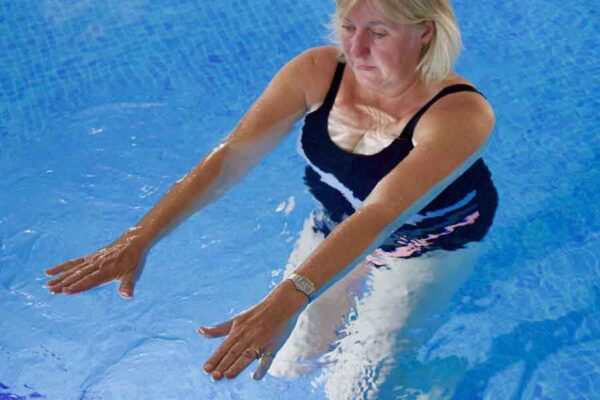
Straight arms, with soft elbows, slowly take arms forward and back.
With straight arms lift them out to side and bring them back down to your side
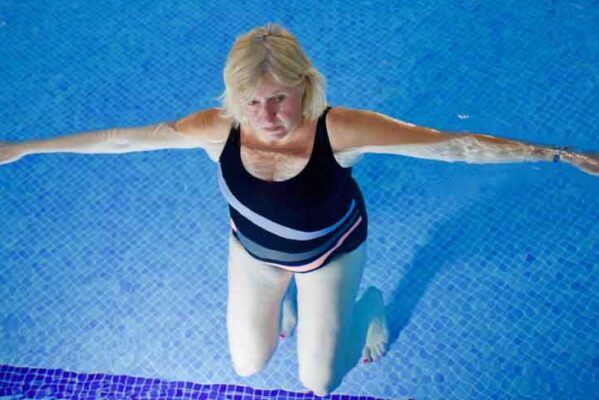

Straight arms lift out to side, bring hands together in mid line.
Then take arms in and out.
When you are stronger this can be resisted by holding a bat.
Straight arms lift out to side then carry the right arm across your body to reach and touch the left hand.
Repeat with the other arm.
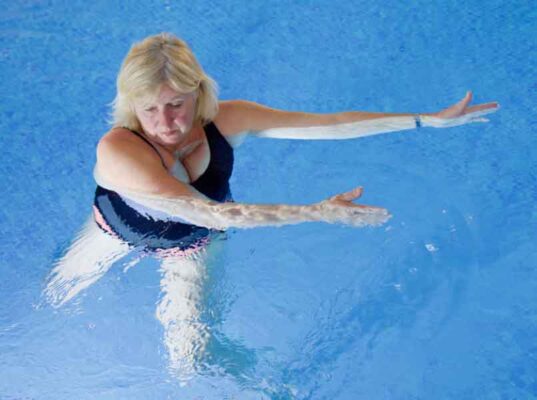
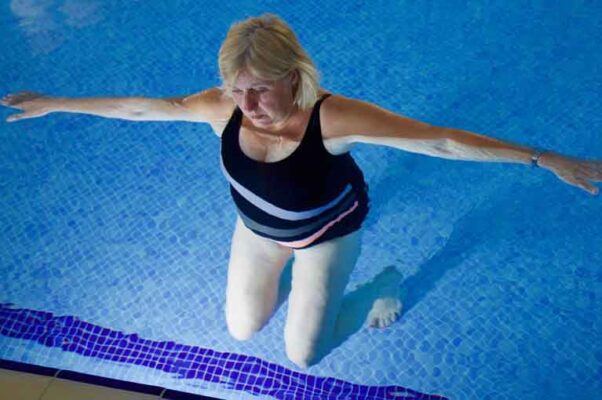
With straight arms lift them out to side and slowly circle them a) forwards, b) backwards
Stand and lean forwards and swing the arm like a pendulum.
Then do it in circles both ways
see below for video
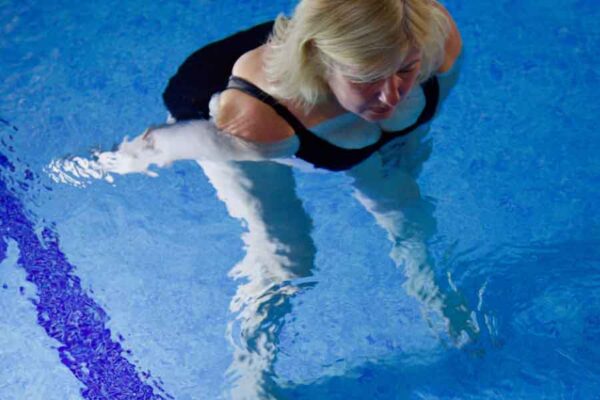
Arms by your side, bend elbows to 90º. Take your forearms in and out across your body.
See above for video
Take your straight arms out to side and bend elbows to 90º. Lift forearms to bring hands out of water and rotate forearms to take hands into the water.
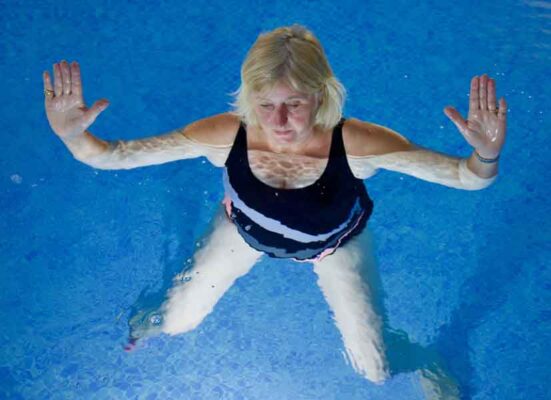
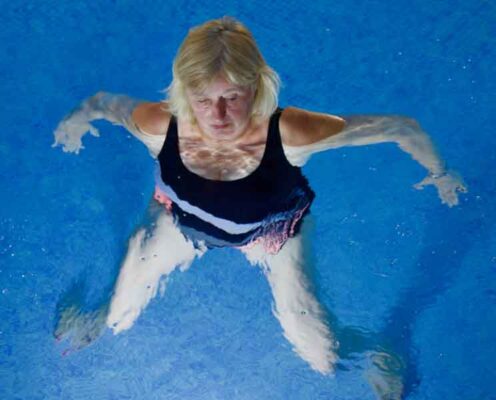
Straight arms out to side. Take your hands in and out behind your back

Standing do doggy paddle/ crawl arms in the water
With your hands together. Circle your arms to stir the water
a. Clockwise
b. Anticlockwise
c. Figures of eight both directions

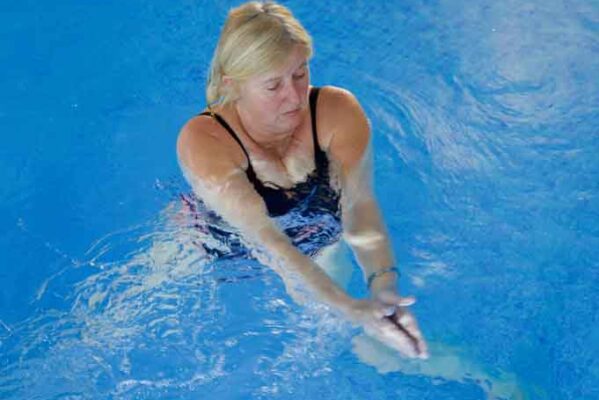
With your hands together do a golf swing through the water.
https://youtu.be/QxXmjfK–DY
Swing your straight arms one forward while the other one goes back.
Biceps curls
With elbows by your side and at 90º and palms up. Bend and straighten your elbows
This can then be progressed to do with a bottle of water
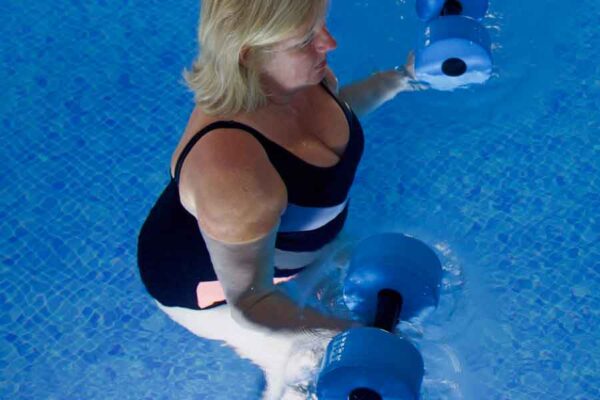
Triceps curls
With elbows by your side and at 90ºand palms down. Bend and straighten elbows.
Then with your elbows by your side and at 90º palms facing up take your forearms out to side and gradually straighten your . elbows and return to your starting position.
Repeat.
Keep your shoulder blades down and still throughout. Progress by pushing down on a float or holding arm bands or such like
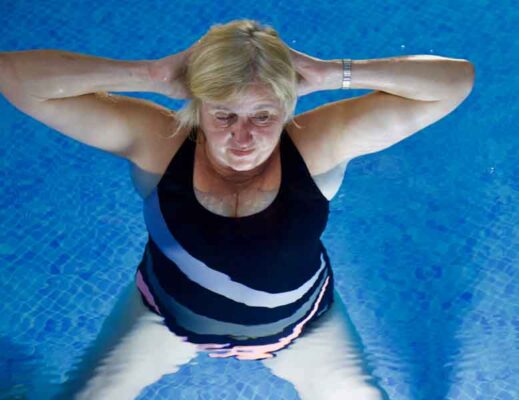
Stand with hands on your head and push elbows out
Punch each arm forwards in to the water in front of you

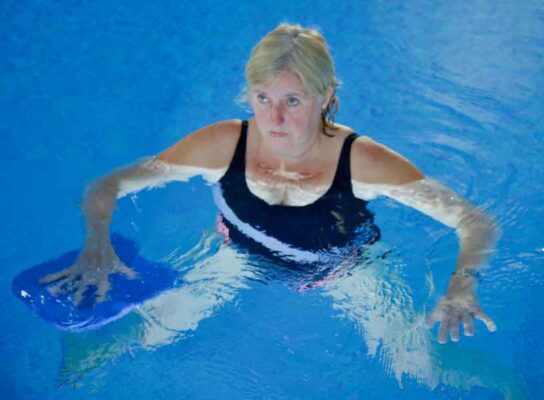
With one hand resting on the float take it out across the water and then carry it across to the other hand.
Change hands
See video above
Stand with arms out at 90 on top of water then bring them together crossing them over in the front
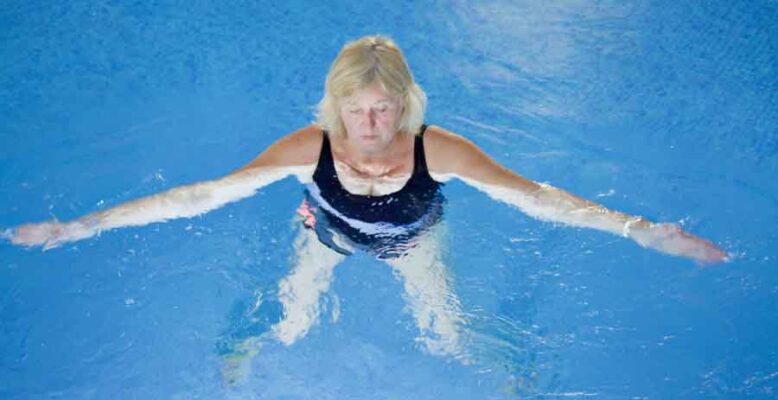
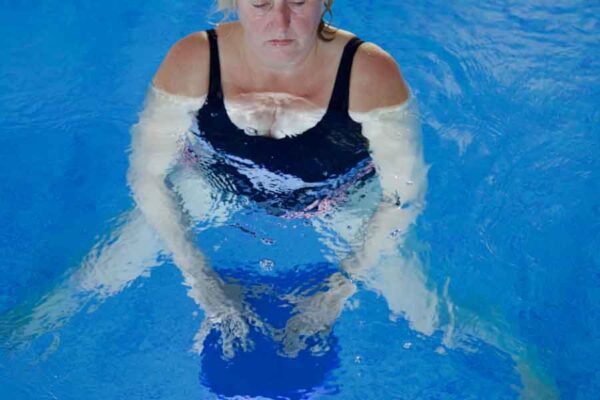
With both hands on the float press it down in to the water
Take both arms down and try and get them as far as you can behind your back
Hug yourself and then push both arms out again
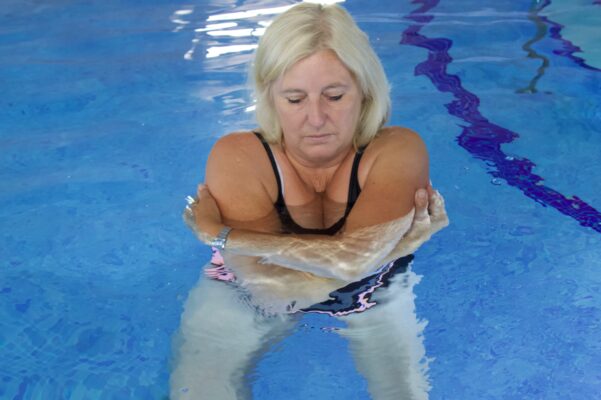

Pass an arm band behind your back and then behind your neck.
Stand lean in to wall support yourself with hand of unaffected arm. on side of pool
Take your free straight arm diagonally up and across turning hand to palm up as you go to touch wall by the supporting hand. Then take the arm back down and out turning palm down as you go.
Place both hands on the wall/side of pool.
Perform press ups. Do not allow body to twist
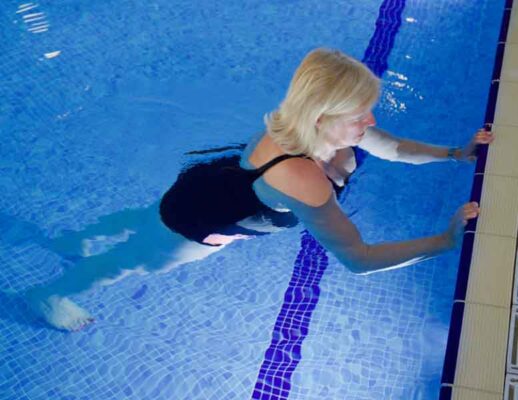
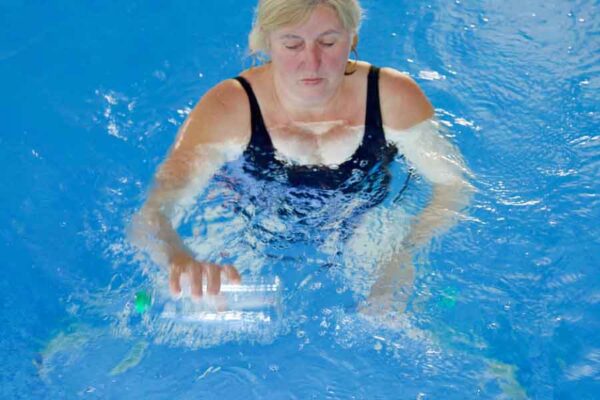
Holding empty water bottles do circles in the water.
Then take them down in to the water to your hips and then straight back up controlling the movement.
See above video
When able and happy to do so:
Using woggle for support under waist and wearing a collar, Float out on back.
- Take straight arms out from side and back in.
- Lift arms up over head and back down.
- Double arm backstroke. B) single arm backstroke.
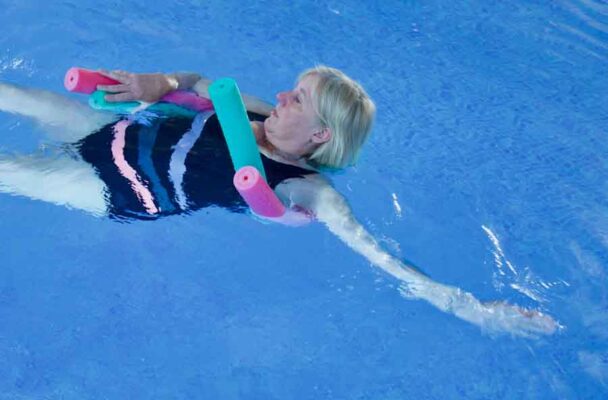
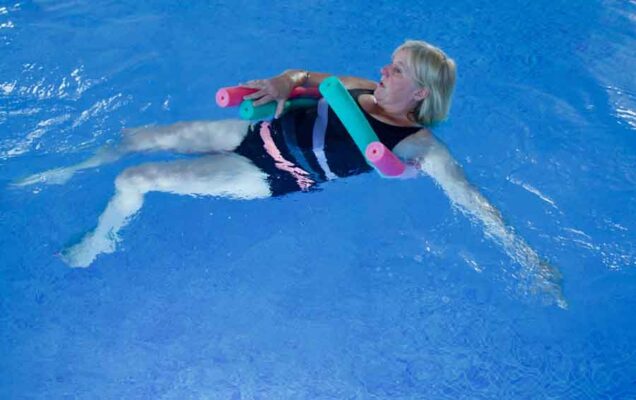
Swim if you are able or walk performing stroke action
Doggy paddle, Breaststroke, Backstroke, Crawl.
Progress to swimming with float single arm action.
Whole film of the exercises program
Specific Advice for Exercises in Water following Shoulder Surgery
Always discuss your plans for exercising in water with your Consultant or Physio.
Always keep within the physiotherapy protocol you will have been given.
Exercises in water are extremely beneficial after shoulder surgery, once the wound is healed and you are out of the sling. You should be aware of the shoulder protocol of exercises provided by your consultant and abide by them even when in the water, that said the water is a very helpful tool to aid recovery, it can be used to support the arm whilst exercising or by using a buoyant aid, a bottle/dumbell or float, allow for passive exercise. As progress is made and as strength returns the buoyancy aid can be used as resistance.
Shoulder Manipulation under anaesthetic MUA
Usually performed for a condition known as Frozen Shoulder. It is essential to retain the movement achieved at the time of the manipulation, pool exercise can greatly help in this endeavour, there are no restrictions to range or direction of movement. Work to achieve normal movement and build strength.
Sub Acromial Decompression
Performed for an impingement of a tendon causing pain.
Calcific tendonitis
A deposit of calcium found in the tendon sheath causing pain.
Acromioclavicular (AC joint) joint arthritis
A small joint between the acromium which comes off the top of the shoulder blade and the collar bone (Clavicle) prone to wear which can cause pain.
Following key hole surgical intervention to relieve these three conditions you will have 2/3 small puncture wounds, with no stitches, over the shoulder and leave hospital with a sling, purely for comfort. The latter can be discarded as soon as possible. You may also have had an MUA if the shoulder was found to be stiff. Movement is encouraged from the day following surgery. allow the wounds to heal, usually a week, before starting pool exercises. There are no specific restrictions as to range or direction of movement, except pain. Work to increase range of movement with accompanying control and strength. Expect your shoulder to feel 80% better at 3 months, further progress will come over the following months, do not be disheartened.
Rotator Cuff Tear
The rotator cuff is comprised of a group of 4 muscles that surround the ball of the shoulder joint. As a unit they control the shoulder joint and working with other muscles they assist in moving the arm. Because of their position they are vulnerable to friction resulting in tears. Dependent on the size of tear they are graded, Small, Medium and Large
Not all rotator cuff tears are repaired, this is because the quality of the tissue may be poor, sometimes described as trying to repair a lace curtain, surgery in this instance is ineffective a re tear is possible.
Surgery usually keyhole with 3 small punter wounds, you will leave hospital with a sling, to be worn for varying lengths of time dependant on the size of tear repaired and the specific protocol of your surgeon.
Small repair
Consider starting pool exercises at 6 weeks, discuss this with your hospital Physio who will be over seeing your progress. no resisted exercises initially, work on gradually stretching and regaining functional movements, using water to support the weight of the arm. work on control of the shoulder blade. Work on strength to support increased movement and function, keep within limits of pain.
Breaststroke at 6 weeks, front crawl 3 months.
Medium repair
As above, exercises in water can be commenced from the 6th week, discuss with your hospital physio. Start with exercises using buoyancy aid to support the arm, particular attention should be on shoulder blade control, progress to active movement as strength and control builds.
Swimming Breaststroke at 6 weeks, front crawl 3 months.
Large repair
Pool exercises can start from 8 weeks, as before check with the hospital physio. Then follow regime from gentle supported exercises through active movement to finally to resisted exercises, at 6 months.
Swimming Breaststroke at 12 weeks, front crawl 6 months.
Stabilisation
For recurrent dislocations.
Arthroscopic antero-inferior stabilisations. (Forward Dislocations and Slap tears)
Water exercises from 6 weeks. Start gently, do not over stress the joint, particularly external rotation. Progress as control achieved.
Swimming Breaststroke 8 weeks Front crawl 3 months.
Arthroscopic posterior stabilisations. (Backward Dislocations)
Exercises in water from 6 weeks in consultation with hospital physio. Care to be taken over internal rotation. Progress from gentle supported to active movement do not force movement.
Swimming Breaststroke 8 weeks Front crawl 3 months.
Modified Weaver-Dunn Procedure
For Acromioclavicular dislocations. Joint between top of shoulder blade and collar bone.
Pool exercises can be considered between 6 to 12 weeks, ask your hospital physio, the arm should not be lifted above 90 degrees for 12 weeks post op.
At 12 weeks work gently into all ranges of movement including active movement above 90 degrees.
Swimming Breaststroke 8 weeks Front crawl 3 months.
Surface replacement arthroplasty
For younger patients with arthritis of the shoulder joint (Glenohumeral Joint) with aim to relieve pail, improve movement and stability.
Exercises in water can commence once wound has healed between 1-3weeks post op, but check with your treating physio, or Consultant.
External rotation only to neutral, or safe range, make sure you understand this by asking Physio.
6 weeks onwards progress to achieve full range of shoulder movement, build strength and stability.
Swimming Breaststroke 6 weeks Front crawl 3 months.
Verso Reversed Geometry Total Shoulder Replacement
As the name implies the position of the ball and socket are reversed. The result is a more efficient joint with better function and stability and decreased pain.
Pool exercises under the discretion of your treating physio or consultant.
Swimming Breaststroke 3-12weeks Front crawl 3 months.
Hemi-arthroplasty following trauma/fracture
The ball (Humeral Head) is replaced by an artificial head.
6 weeks plus, pool exercises can start, consult treating physio. work into all ranges of movement as pain allows.
Swimming Breaststroke 8 weeks Front crawl not before 3 months.
